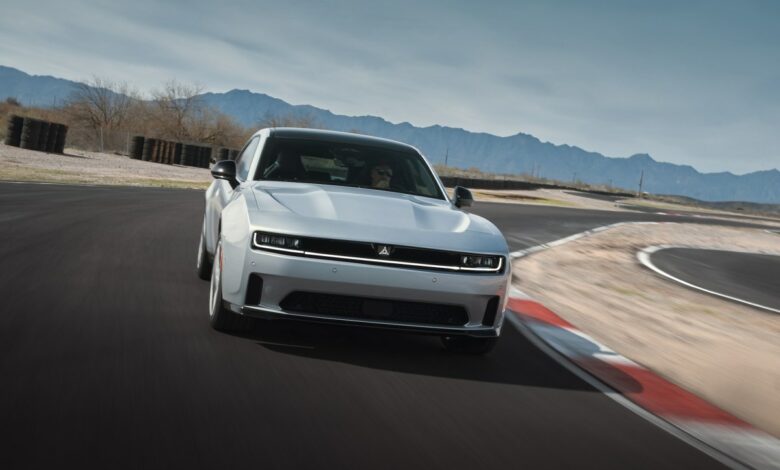The 2024 all-electric Dodge Charger debuts with muscle car donuts, drifts and even a Hellcat rumble

Stellantis introduced Tuesday two all-electric versions of the Dodge Charger packed with the kind of features muscle car fans have come to expect — right down to a system that tries to mimic the rumble of a Hemi V-8 engine.
The two new Dodge Charger EV coupes — the 2024 Charger Daytona Scat Pack and the milder Daytona R/T trim — are scheduled to enter production in mid-2024. Production of four-door versions begins in the first quarter of 2025. The automaker did not release pricing information for any of the vehicles.
Together, these next-generation Dodge Charger coupes are part of parent company Stellantis’ strategic plan to cut its global carbon footprint by 50% by 2030 and achieve net-zero carbon emissions by 2038. That plan also includes some lofty financial targets as well, including doubling net revenues to $335 billion a year by 2030 and maintaining double-digit profit margins.
The Dodge Charger, along with other EVs in the Stellantis portfolio such as the Fiat 500e and the upcoming Ram Ramcharger and Ram 1500 Revolution EV, are all important cogs in the automaker’s strategic plan.
Dodge, perhaps aiming to appease its core customer base, isn’t abandoning gas-powered muscle cars altogether. The brand said the next-generation Charger will also be offered with internal combustion engines. These will not be powered by a Hemi V-8, however. The automaker is instead using a more efficient and cleaner burning 3-liter twin-turbo Hurricane inline-six engines that Dodge brand chief executive officer Tim Kuniskis says offers more power and torque than the outgoing 5.7 and 6.4-liter Hemi engines.
Gas-powered two-door and four-door Dodge Charger vehicles are also scheduled to begin production in the first quarter of 2025. The entire lineup, including the battery electric versions, will be assembled at the company’s factory in Windsor, Canada.
The 2024 Dodge Charger launch comes at a precarious time for U.S. and European automakers attempting to navigate an ever-changing EV landscape, where Chinese manufacturers continue to gain ground. Even as EV market share has expanded, automakers have paused or downsized factory buildouts for EV assembly or battery manufacturing amid softening demand — particularly for higher priced luxury EVs.
But Stellantis CEO Carlos Tavares told TechCrunch in an interview last month that the automaker is not following its competitors’ lead and instead is going “flat out” on EVs.
“I’m keeping it flat out. Flat out on the EVs for several reasons,” Tavares said, adding that the company is not turning its back on gas-powered vehicles either. Tavares said he’s future-proofing the company to prepare for either result in upcoming political races in Europe and the United States that involve dogmatic and populist candidates who have threatened to roll back pro-environmental regulations and incentives.
“Thanks to the 2030 strategic plan, I have the leisure and the privilege of not having to bet on what these elections results will be,” he added. “I can wait until the end of ’24; then I will decide whether to move more capacity, invest in the capacity or not invest, based on an acceleration that will be driven by a dogmatic scenario or based on the slowdown that could be driven by the populist scenario. So that’s why we keep it flat out.”
EV nuts and bolts
The 2024 Charger Daytona Scat Pack and Daytona R/T trim will come standard with all-wheel drive and a 100.5 kilowatt-hour battery pack. From here, the customer will need to prioritize speed and torque or range.
The 2024 Charger Daytona Scat Pack will deliver 670 horsepower, be able to accelerate from zero to 60 miles per hour in 3.3 seconds, run a quarter-mile in an estimated 11.5 seconds and reach a top speed of 134 mph. That power and acceleration comes with a trade off; the Scat Pack’s estimated range is 260 miles.
Meanwhile, the Daytona R/T trim will produce 496-horsepower, travel 0 to 60 mph in a slightly slower 4.7 seconds, but with a longer estimated range of 317 miles.
Both EVs come with a Fratzonic Chambered Exhaust ajargony branded term that describes a system Dodge created to send sound through an amplifier and tuning chamber in an effort to mimic the iconic growl of a Hemi V-8 engine.
The two trims diverge once drifting, donuts, track and drag driving modes come into play. Those driving modes, which are available in the Scat Pack trim, perform like they sound. Track mode is designed to deliver maximum vehicle performance on smooth, dry surfaces, while drag mode is meant for use on an enclosed dragstrip for launch and straight-line acceleration. Donut and drift modes allow the vehicle to drift — drivers can select three levels of slip angle — and spin only the rear wheels and to rotate around either of the front wheels without intervention from the traction control system to achieve the perfect donut.
Source link





